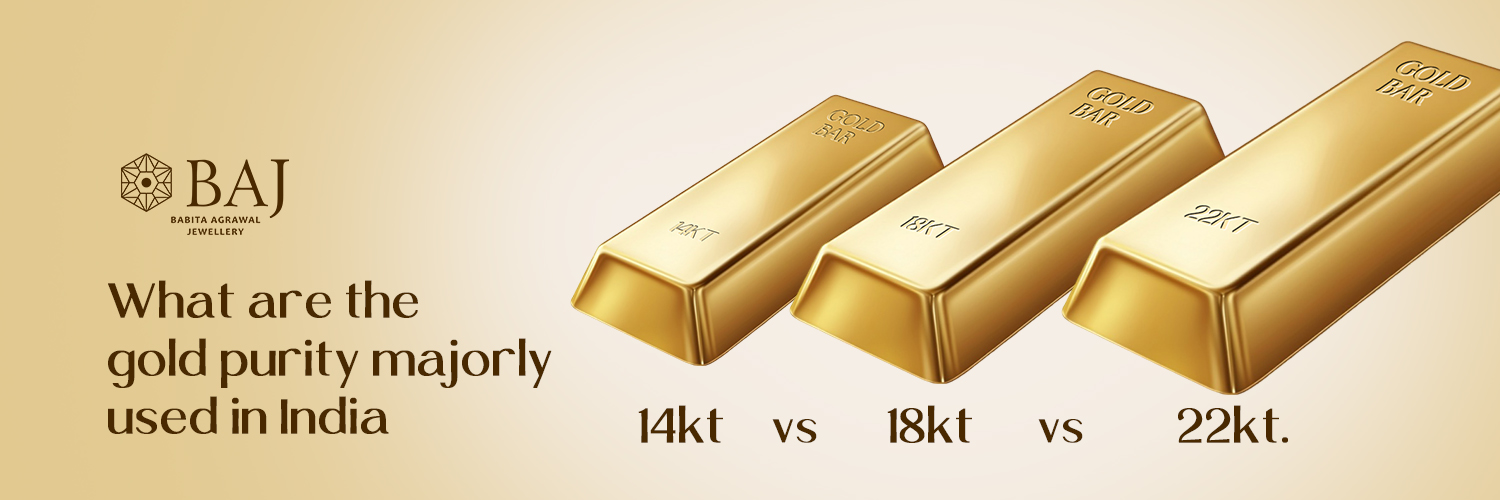
What Are the Gold Purities Majorly Used in India: 14kt vs 18kt vs 22kt
In India, gold is more than just a precious metal; it is a symbol of prosperity, tradition, and timeless elegance. Understanding the purity levels of gold jewellery is essential. In India, the most common gold purities used for jewellery are 14 karat (kt), 18 karat (kt), and 22 karat (kt). Each purity level offers a unique balance of durability, appearance, and value.
In this blog, we’ll explore the differences between 14kt, 18kt, and 22kt gold, their characteristics, and which purity is ideal for different types of jewellery.
What Does Karat (kt) Mean in Gold?
The term karat (kt) is used to measure the purity of gold.
- Pure gold is 24kt, which means it contains 99.9% gold.
- Since pure gold is soft and malleable, it is often mixed with other metals (like copper, silver, or zinc) to enhance its durability for jewellery making.
- The karat value indicates the proportion of gold in the alloy.
Formula: Gold Purity = Karat/24×100
For example:
- 22kt gold contains 91.67% pure gold and 8.33% other metals, often including copper or silver.
- 18kt gold contains 75% gold and 25% alloy metals.
- 14kt gold contains 58.3% gold and 41.7% alloy metals.
14kt Gold: The Durable and Affordable Choice
14kt gold is composed of 58.3% pure gold and 41.7% alloy metals.
- It is more durable and resistant to scratches and dents compared to higher purities.
- Since it contains less pure gold, 14kt jewellery is more affordable.
- The color of 14kt gold is slightly paler than 18kt or 22kt.
Ideal For:
– Jewellery with gemstones (due to better durability)
– Engagement rings and wedding bands
18kt Gold: The Perfect Balance of Purity and Strength
18kt gold contains 75% pure gold and 25% alloy metals.
- It offers a beautiful, rich yellow hue while being stronger and more durable than 22kt gold.
- Due to its high purity, 18kt jewellery is slightly more expensive than 14kt.
- It is a popular choice for diamond and gemstone-studded jewellery, as it holds stones securely.
Ideal For:
– Fine jewellery with diamonds or gemstones
– Wedding bands and luxury pieces
– Special occasion jewellery
22kt Gold: The Traditional Favourite
22kt gold is made of 91.6% pure gold and 8.4% alloy metals.
- It has a deep, rich yellow color, making it visually striking.
- However, 22kt jewellery is softer and more prone to scratches and bending.
- It is not recommended for stone-studded jewellery due to its softness but is perfect for traditional gold bangles, necklaces, and chains.
Ideal For:
– Traditional Indian gold jewellery
– Bridal collections and ceremonial pieces
– Plain gold jewellery without stones
14kt vs 18kt vs 22kt: Which One Should You Choose?
For Daily Wear- Choose 14kt gold for its durability and affordability.
For Diamond and Stone Jewellery- Opt for 18kt gold as it offers the right balance of strength and purity.
For Traditional Gold Jewellery- Go for 22kt gold, perfect for heirloom and ceremonial pieces.
Conclusion
Choosing the right gold purity depends on your lifestyle, usage, and budget.
- 18kt gold offers the perfect blend of purity and durability, making it popular for fine jewellery.
- 22kt gold is the preferred choice for traditional Indian gold jewellery due to its rich appearance.
At Babita Agrawal Jewellery, we offer a wide range of exquisite gold jewellery in various purities, ensuring you find the perfect piece for every occasion.
Explore our collection today and discover timeless elegance!
Have something in mind? Let us call you back.
Get in touch
Get in touch
Information
COPYRIGHT © 2025 BABITA AGRAWAL JEWELLERY